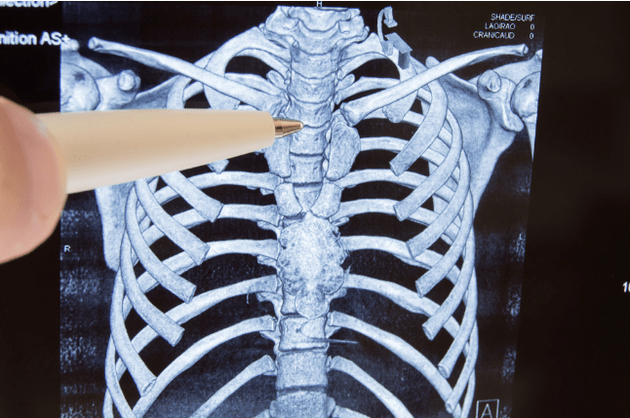Osteochondrosis is a vertebral column disease in which the intervertebral discs (and subsequently the body of the vertebrae, joints and ligaments) lose their ability to function normal.

The cause of osteochondosis is currently considered a set of factors that affect the spine during a person's life.An additional risk of osteochondosis develops the resulting injuries from the spine, as well as a posture disturbance.Some patients note the link at the start of the disease and hypothermia.
In practice, it is usual to consider
- cervical osteochondrosis,
- Thoracic osteochondrosis and
- Lumbar spine.
In addition, it should be noted that osteochondrosis is common, characterized by damage to several parts of the spine at a time.
The most common is the cervical and thoracic forms, because it is these departments of the spine that are subject to the greatest loads.
Symptoms of osteochondrosis
With osteochondrosis, patients describe symptoms such as:
- Paroxysmal pain or shooting in the spine affected by osteochondrosis;
- Increased pain after physical effort, as well as in the morning;
- The pain can be given on the neck, arm or leg, as well as the chest;
- Feeling of crunch when twisted.
Osteochondrosis is also characterized by symptoms of a neurological nature on the affected side:
- partial movement violations (paresis);
- Unpleasant sensations in the form of goosebumps, tingling (paraesthesia);
- At palpation, the tension of the muscles corresponding to the affected department is determined.
The disease begins and develops gradually, not strongly.
It is necessary to distinguish osteochondrosis from the spine from coronary diseases (with coronary disease, the occurrence of pain is not associated with physical activity, but is due to secondary factors: cough, prolonged seat).
Treatment
The same symptoms can be signs of various diseases and the disease may not occur depending on the manual.Do not try to be treated yourself - consult your doctor.
Osteochondosis therapy always requires an integrated approach.In the treatment, the attention of doctors such as the therapist, the rheumatologist, the neuropathologist and the physiotherapist is necessary.The treatment of osteochondrosis of the spine depends on the location, the dominant symptoms and the severity of the disease.
Conservative therapy aims to eliminate symptoms of pain, as well as to restore the normal function of the spine.
The rational nutrition of osteochondosis considerably facilitates the patient's condition and promotes more effective therapy.Learn more about the principles of nutrition of osteochondrosis in our separate article.
About 10% of patients are sent for surgical treatment.The absolute indicator of surgical intervention in osteochondrosis is the appearance of neurological disorders due to the pinch of the spinal cord itself.
Additional indicators for surgical treatment of osteochondrosis are considered as follows:
- extended periodic attacks of pain;
- Increased mobility and suspicion of instability in the spine;
- the ineffectiveness of the drug for 3 months;
- Pronounced disorders that prevent the patient from leading a full life.
Surgical treatment methods
Surgical interventions with minimal trauma:
- Preparations-Injuctions-Enzymes The preparations are administered in the intervertebral disc after firing for the scars of the core and the fibrous ring of the disc.
- Punctomy nucleotomy - Question of the intervertebral disc to eliminate part of the poison.
- Disner Disnervation - A drug is introduced into the intervertebral disc which blocks the sensitivity of nerve endings.
The remaining methods of surgical treatment of osteochondrosis of the spine are less soft.These include:
- Complete or partial elimination of the intervertebral disc or its hernia - this operation aims to reduce compression symptoms.
- Prothetics of intervertebral discs - The main task is to repair the affected vertebral segments.
Operational methods of processing osteochondrosis in the spine provide a forecast for complete recovery in only 50% of cases.
With a timely treatment, the life prognosis is almost always favorable, but the prognosis for work capacity may be different due to a certain number of factors.
Osteochondrosis exercises
Exercise 1.
Tilt your head forward, while pressing the forehead with woven fingers.Press your fingers closely at the back of the head and whiskey - left, right.The head thwarts the pressure of the hands and hands - the pressure of the head.Spend 10 seconds.For each movement.
Exercise 2.
Put the four fingers on the forehead against each other, gently press the skin with the entire surface of the palm and with mild traction movements stretch it for 10 to 40 seconds.We can make the same stretching in the temple in the longitudinal and transversal direction.The same - on the ear - to stretch it in all directions, especially the lobe.That.You improve blood circulation in areas rich in biologically active points.
Exercise 3.
This type of massage improves blood circulation in the jugular veins and brain nutrition improves.Sit exactly, the back is straight.Take your head slowly, helping with your hand, pressing the chin back and upwards.You can turn your head slowly on the left and right.Stay in this position for about a minute.For children, 10 seconds are enough.
Exercise 4.
This exercise improves the functioning of the cervical nervous plexus.Sit exactly, the back is straight.Slowly tilt your head forward, trying to touch the chin from your chest.Put your fingers woven at the back of the head, press the front and upwards, lifting at the back of the head.Sit like that for about a minute.After 15 minutes, you can repeat.
Exercise 5.
Raise your shoulders, trying to put it on your ears, lower, free, faster - for 15 seconds.Now alternately - one shoulder at the top, the other is down, also 15 seconds.Pull the cervical column with your palms.






















